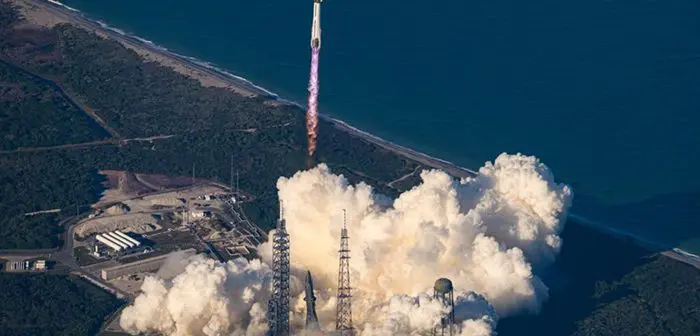
A pair of NASA spacecraft destined for Mars will study how the planet’s magnetic environment is shaped by the Sun, while also helping the agency prepare for future human exploration of the Red Planet.
NASA’s ESCAPADE (Escape and Plasma Acceleration and Dynamics Explorers) mission launched at 7:55 a.m. AEDT on Friday aboard a Blue Origin New Glenn rocket from Launch Complex 36 at Cape Canaveral Space Force Station in Florida.
Acting NASA Administrator Sean Duffy said the mission would contribute to understanding how Mars evolved into a cold, arid world and how solar events continue to affect it today. “Congratulations to Blue Origin, Rocket Lab, UC Berkeley, and all our partners on the successful launch of ESCAPADE. This heliophysics mission will help reveal how Mars became a desert planet, and how solar eruptions affect the Martian surface. Every launch of New Glenn provides data that will be essential when we launch MK-1 through Artemis. All this information will be critical to protect future NASA explorers and invaluable as we evaluate how to deliver on President Trump’s vision of planting the Stars and Stripes on Mars.”
The twin spacecraft, built by Rocket Lab and led scientifically by the University of California, Berkeley, will investigate how the solar wind — a constant, million-mile-per-hour stream of charged particles — gradually stripped Mars of much of its atmosphere. That process contributed to the loss of surface water and the cooling of the Martian climate.
Ground controllers established communications with both spacecraft at 2:35 p.m. AEDT on Friday.
Nicky Fox, associate administrator for NASA’s Science Mission Directorate, said the mission aligns with long-term human exploration goals. “The ESCAPADE mission is part of our strategy to understand Mars’ past and present so we can send the first astronauts there safely. Understanding Martian space weather is a top priority for future missions because it helps us protect systems, robots, and most importantly, humans, in extreme environments.”
New Glenn also carried a space communications technology demonstration developed by Viasat Inc., supporting NASA’s efforts to commercialise next-generation satellite relay services. The system transmitted launch telemetry from the rocket’s second stage through Viasat’s geostationary network as part of NASA’s Communications Services Project.
Recent heightened solar activity, which triggered widespread auroras on Earth, caused a slight delay to protect the spacecraft during early commissioning. Once at Mars, ESCAPADE will study the real-time effects of solar storms and the solar wind, helping NASA better understand the conditions astronauts will face.
ESCAPADE program executive Alan Zide said the spacecraft are embarking on a trajectory no previous Mars mission has taken. Rather than flying directly to Mars, the pair will travel first to the Sun–Earth Lagrange Point 2, about 1.5 million kilometres from Earth. Mars and Earth are currently positioned on opposite sides of the Sun, making direct travel inefficient. In November 2026, when the planets are properly aligned, the spacecraft will loop back toward Earth and use gravity assist to send them on their way to Mars.
The mission’s “Earth-proximity” or “loiter” trajectory could allow future spacecraft to launch at more flexible times and wait in deep space until conditions are right for interplanetary transit. ESCAPADE will also become the first mission to traverse the distant region of Earth’s magnetotail, where the planet’s magnetic field is stretched by the solar wind.
After a 10-month cruise, the spacecraft are expected to arrive at Mars in September 2027, becoming the first coordinated dual-spacecraft mission to enter orbit around another planet. Over several months, they will form an initial “string-of-pearls” formation, flying through the same regions in quick succession to measure short-term variability in space weather. This science phase is scheduled to begin in June 2028.
Six months later, the spacecraft will separate into different orbital altitudes to simultaneously measure the solar wind and Mars’ upper atmosphere, helping researchers understand how the planet responds to solar activity in real time. The mission will also gather data on Mars’ ionosphere, a region that future astronauts will rely on for radio communication and navigation.
ESCAPADE is funded by NASA’s Heliophysics Division as part of the Small Innovative Missions for Planetary Exploration program. NASA’s Goddard Space Flight Center, Embry-Riddle Aeronautical University and Advanced Space are supporting mission activities. NASA’s Launch Services Program at Kennedy Space Center procured the New Glenn launch under the Venture-class Acquisition of Dedicated and Rideshare contract.
Image: NASA’s ESCAPADE (Escape and Plasma Acceleration and Dynamics Explorers) mission launched at 3:55 p.m. EST atop a Blue Origin New Glenn rocket at Launch Complex 36 at Cape Canaveral Space Force Station in Florida. Credit: Blue Origin





